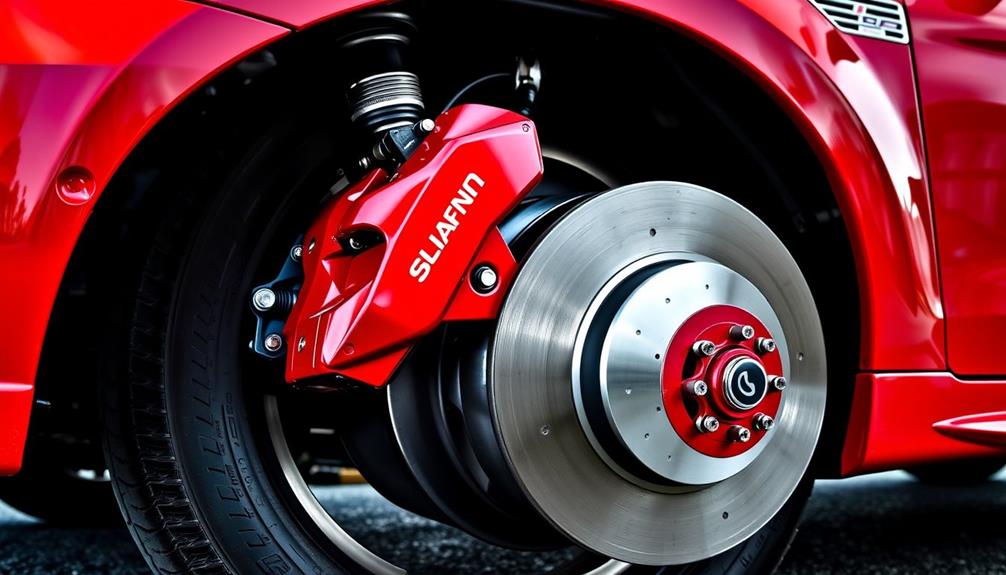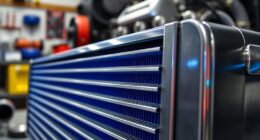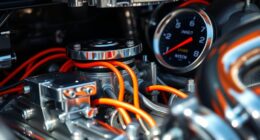Tuning your Ford Sierra is a fantastic way to make your classic car a true performance machine. Start by considering engine swaps, like the turbocharged Cosworth YB engine, to boost horsepower considerably. Upgrading the suspension with adjustable coilovers enhances handling, while improved brake components guarantee you can stop on a dime. Don't forget about the interior; swapping in Recaro seats not only looks great but also provides comfort and support. With a strong community backing you, you'll find endless inspiration and advice for your tuning journey. There's so much more to explore in transforming your Sierra into a standout ride. Consider adding other Ford performance upgrades like a high-flow exhaust system and a cold-air intake to further enhance the power and efficiency of your Sierra. Upgrading the wheels and tires can also improve the overall look and performance of your car. With the right combination of modifications and upgrades, your Ford Sierra can become a true showcase of classic car performance and style.
Key Takeaways
- Upgrading to a turbocharged Cosworth YB engine can significantly boost power to over 220bhp with minor modifications.
- Adjustable coilover suspension enhances handling, allowing for customized ride height and improved performance on the road or track.
- Upgrading to larger brake components and high-performance calipers ensures enhanced stopping power and reduces brake fade during intense driving.
- Lightweight materials in both the engine and interior can contribute to overall performance improvements by reducing weight.
- Engaging with online forums and local car clubs provides valuable resources and community support for your tuning projects.
Overview of the Ford Sierra
When you think about iconic British cars, the Ford Sierra often comes to mind. Launched in 1982 as a replacement for the Cortina, the Sierra maintained a rear-wheel drive layout while many competitors shifted to front-wheel drive. This choice contributed to its impressive handling and performance, making it a favorite among enthusiasts.
The innovative chassis featured MacPherson struts in the front and independent rear suspension, enhancing its capability on the road.
Over its decade-long production run, the Ford Sierra introduced various models, including the high-performance XR versions and even a four-wheel-drive option. This versatility allowed it to appeal to a broad audience, from everyday drivers to performance seekers.
One significant variant that emerged was the Sierra Sapphire, offering a more spacious design suitable for families without sacrificing the performance fans craved.
Initially, the Sierra's popularity took time to build, but it eventually became a staple in the UK and European markets. Its combination of style, practicality, and performance potential set it apart, even when compared to rivals like the Ford Escort.
With its rich history, the Ford Sierra remains a beloved classic that continues to inspire car enthusiasts today.
Engine Swaps and Upgrades

Engine swaps and upgrades are frequently sought after by Ford Sierra enthusiasts looking to enhance performance and reliability. One of the most popular choices is the turbocharged Cosworth YB engine, capable of producing over 220bhp with minimal modifications.
If you're aiming for even higher power levels, the Saab B204 engine is an excellent option. With robust internals, it can reach up to 480 horsepower after ECU mapping, especially when paired with high-performance components.
Another viable alternative is the Nissan CA18DET, which offers substantial performance improvements and fits well with common tuning modifications.
When considering these engine swaps, it's wise to think about the M90 gearbox from Volvo models. This gearbox is known for its durability and high torque handling, making your conversion process smoother.
To guarantee a successful engine integration, you'll need a solid grasp of wiring and ECU setup. Options like Saab's Trionic 5 management system or aftermarket ECUs, such as MegaSquirt, can help you maximize your engine's potential.
With the right engine swap, you can transform your Ford Sierra RS into a true performance machine.
Suspension and Handling Enhancements

If you want to take your Ford Sierra's performance to the next level, upgrading to adjustable coilover suspension is a must.
Not only will it let you customize your ride height and handling, but pairing it with an upgraded braking system will guarantee you can stop as efficiently as you can go.
With these enhancements, you'll experience a significant boost in both stability and cornering grip.
Adjustable Coilover Suspension
How can you elevate your Ford Sierra's performance to new heights? Installing an adjustable coilover suspension is a game-changer. These kits let you customize ride height and stiffness, directly impacting your car's handling characteristics. By replacing the standard shocks and springs, you'll experience enhanced stability and improved cornering capabilities.
With adjustable damping settings, you can fine-tune your suspension for both daily driving and track performance. Lowering the center of gravity reduces body roll, making your Ford Sierra more responsive during maneuvers.
Whether you prefer a stiffer setup for competitive racing or a softer ride for everyday use, you've got options. Many coilover kits come with a range of spring rates and damping choices, allowing you to tailor the setup to your driving style and conditions.
Additionally, upgrading to adjustable coilovers not only boosts performance but also elevates aesthetics. You can achieve a more aggressive stance while maintaining ideal suspension performance.
Upgraded Braking Systems
While enhancing your Ford Sierra's performance with adjustable coilovers, don't overlook the importance of upgrading your braking system. Upgraded braking systems can greatly boost your stopping power, ensuring your classic car handles well under pressure.
Consider investing in big brake kits if you're planning serious track use; these kits improve heat dissipation and pedal feel, which are essential for maintaining control.
You can also opt for smaller 295mm disc kits that fit perfectly with stock 15-inch alloys, keeping your classic aesthetic intact. Pairing upgraded discs and pads with braided hoses will enhance your braking performance, reducing brake fade and improving response times during intense driving.
For even finer control, the exchange bias pedal box allows you to customize your braking setup according to your driving style, giving you the precision you need on the road or track.
Remember, suspension upgrades like adjustable coilovers should work in harmony with your braking enhancements, ensuring your Sierra maintains a balanced feel during aggressive maneuvers.
Braking System Improvements

When tuning your Ford Sierra, improving the braking system is essential for enhanced stopping power.
Upgrading to larger discs and high-performance calipers not only boosts your brakes' effectiveness but also minimizes fade during intense driving.
Upgraded Brake Components
Upgrading the braking components on your Ford Sierra can dramatically enhance its overall performance and safety. By replacing the standard four-pot calipers and 283mm discs, you'll experience a noticeable improvement in braking performance, especially when paired with fast-road pads and full rebuild kits.
Consider these essential upgrades for a more responsive braking system:
- Big brake kit: Choose between 295mm discs that fit stock 15-inch alloys or go for six-pot calipers with 350mm discs for maximum performance.
- Braided brake hoses: Swap out standard rubber lines for braided hoses to improve brake pedal response and fluid delivery, ensuring effective braking during high-performance driving.
- Upgraded suspension bushings: Opt for polyurethane bushings to enhance stability and reduce flex, improving the overall feel of your braking system.
Moreover, incorporating an exchange bias pedal box can offer precise braking control, making it a must for serious performance applications.
With these upgraded brake components, you'll not only boost your Sierra's performance but also enjoy a safer and more exhilarating driving experience.
Enhanced Stopping Power
To achieve enhanced stopping power in your Ford Sierra, investing in improved braking system components is crucial. Upgrading from the standard four-pot calipers and 283mm discs can dramatically enhance braking performance, giving you better stopping power and quicker response.
Consider installing a big brake kit—options with six-pot calipers and 350mm discs not only boost performance but also elevate your car's aesthetics.
To modernize your braking system, utilize full rebuild kits and fast-road pads. These enhancements guarantee improved heat dissipation and reduce fade during high-performance driving, allowing you to push your Sierra to its limits.
Don't overlook the importance of braided hoses; by replacing standard rubber brake lines, you'll achieve a firmer pedal feel and improved brake response due to minimized flex under pressure.
If you're aiming for track-focused setups, adjusting your braking system is crucial. Switching to an exchange bias pedal box grants you precise braking control, tailored to your driving style.
With these upgrades, you'll experience enhanced stopping power that matches your performance ambitions, making your Ford Sierra not just a classic car, but a true performance machine.
Interior Customization Options

Interior customization options for the Ford Sierra can transform your driving experience, making it more comfortable and visually appealing. By upgrading various elements, you can create a space that's not only functional but also reflects your personal style.
Additionally, investing in quality interior upgrades can be seen as a form of asset diversification, enhancing both the vehicle's value and your enjoyment.
Consider these enhancements to elevate your interior:
- Mitsubishi Lancer Evolution VII Recaro front seats, re-trimmed in suede, provide exceptional comfort and support for spirited driving.
- Upgraded gauges and a modern audio system can enhance functionality, making each drive more engaging and enjoyable.
- A bespoke steering wheel and gear knob add a personalized touch, strengthening your connection with the vehicle.
Incorporating lightweight materials during your interior customization can lead to significant weight reduction, improving overall performance.
Opting for a rear bench sourced from the Sierra Sapphire RS Cosworth allows you to maintain a classic aesthetic while ensuring compatibility.
With these upgrades, not only will your Ford Sierra look stunning, but it will also offer a driving experience that's both exhilarating and comfortable.
Embrace these interior customization options to truly make your classic car a performance machine tailored to you.
Community and Support Resources

The Ford Sierra community is a vibrant network of enthusiasts enthusiastic to share knowledge and support one another in their tuning journeys.
Online forums, like the UK Volvo Forum, offer a wealth of resources where you can immerse yourself in discussions about tuning and modifications. Here, you'll find invaluable advice from fellow enthusiasts who've tackled similar projects.
Local car clubs frequently host events and meetups that provide excellent networking opportunities. These gatherings allow you to connect with other Sierra lovers, share experiences, and gain practical insights on performance upgrades.
Dedicated social media groups also enhance community engagement, showcasing modifications and inspiring you to take your tuning to the next level.
Additionally, community contributions often include parts lists, tuning guides, and instructional videos, all designed to assist you in your performance enhancement efforts.
Websites documenting historical data on engine conversions and aftermarket parts are invaluable resources, guiding you through effective modifications.
Frequently Asked Questions
How Much Is a Sierra Cosworth RS500 Worth?
A Sierra Cosworth RS500's worth can range from £30,000 to over £100,000, depending on its condition and mileage. Well-maintained, original models can even fetch upwards of £150,000 at high-profile auctions.
How Many Miles per Gallon Does a Ford Sierra Cosworth Get?
The Ford Sierra Cosworth typically gets around 25 miles per gallon in mixed driving. On the highway, you might see up to 30 mpg, but your driving style can greatly affect fuel efficiency.
How Many Sierra Cosworths Are Left?
Have you ever wondered how many Sierra Cosworths are still around? Approximately 4,000 remain, showcasing their rarity. With around 60% of the original production surviving, these cars continue to captivate enthusiasts and collectors alike.
How Much Horsepower Does a Sierra Sapphire Cosworth Have?
The Sierra Sapphire Cosworth originally boasts 204 horsepower. With modifications, like upgraded turbochargers and ECU tuning, you can easily exceed 220 horsepower, showcasing its impressive tuning potential for performance enthusiasts.
Conclusion
As you take your Ford Sierra from a nostalgic classic to a roaring performance machine, imagine the rumble of your upgraded engine harmonizing with the sleek curves of your custom bodywork. The thrill of sharp handling contrasts with the comfort of a personalized interior, inviting you to hit the road with confidence. With each enhancement, your Sierra transforms—a blend of history and modernity, where the past fuels your passion for the drive ahead. Embrace the journey!










